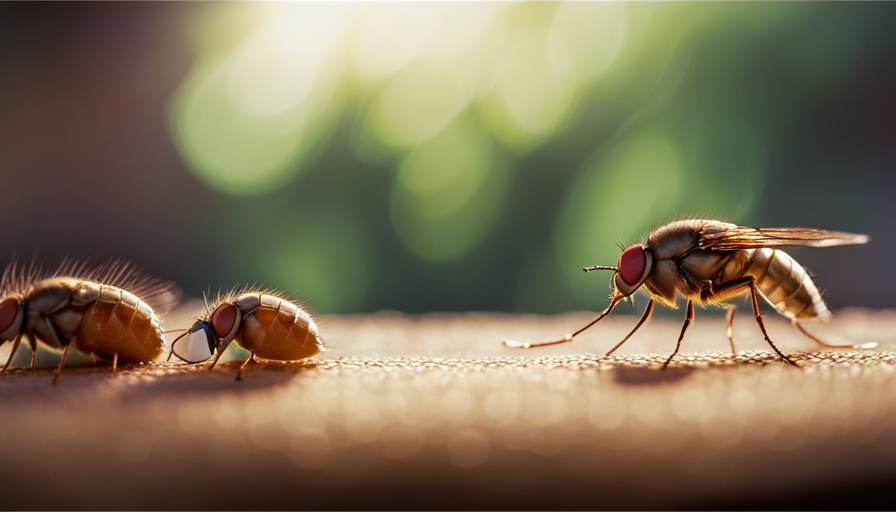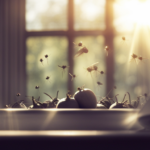In my spacious home, a tiny world of small flies has invaded my living space. As annoying intruders, they buzz around, causing both annoyance and curiosity.
These miniature creatures, with their delicate wings and elusive nature, are a mystery that begs to be unraveled. They are like the whispers of the unseen, hidden in the corners of my kitchen, bathroom, and even near my indoor plants.
But what are these tiny flies that have taken residence in my humble abode?
In this article, I will embark on a scientific investigation to identify and understand these tiny flies that have infiltrated my house. From the common kitchen pests known as fruit flies to the annoying bathroom inhabitants called drain flies, each species possesses unique characteristics and habits.
By delving into their biology and behaviors, we can discover effective methods to prevent future infestations and restore the peaceful harmony of my home.
So, join me on this entomological adventure as we uncover the secrets of these tiny creatures that have made themselves at home in my house.
Key Takeaways
- There are several types of tiny flies that can be found in houses, including fruit flies, drain flies, fungus gnats, cluster flies, house flies, and phorid flies.
- Each type of fly has different behaviors and preferences, such as fruit flies being attracted to ripe or decaying fruits, while drain flies are attracted to organic matter in drains.
- It is possible to control and prevent infestations of these flies by eliminating their food sources, using natural repellents like vinegar or baking soda solutions, and practicing proper sanitation and cleanliness.
- Some flies, like phorid flies, can carry and transmit diseases, so it is important to address underlying issues that attract them and seek professional pest control services if necessary. Ongoing vigilance and attention to cleanliness are key to preventing future infestations.
Identify the Type of Fly
One cannot determine the exact type of flies without further examination. However, there are several common types of tiny flies that can be found in houses.
One of the most common types is the fruit fly, also known as Drosophila melanogaster. Fruit flies are attracted to ripe or decaying fruits and vegetables, as well as sugary substances like juices and sodas. To control fruit flies, it’s important to eliminate their food sources.
Make sure to store fruits and vegetables in the refrigerator or in airtight containers. Clean up any spills or food remnants promptly. Another way to deter fruit flies is by using natural fly repellents such as vinegar traps or essential oils like lemon or eucalyptus. These repellents can help to keep fruit flies away from your home.
Fruit flies are considered common kitchen pests due to their preference for food sources found in kitchens. Therefore, it’s important to take steps to prevent their infestation and keep your kitchen clean and free of attractive food sources.
Fruit Flies: Common Kitchen Pests
In the kitchen, it’s those pesky little bugs that seem to appear out of nowhere. Yes, I’m talking about fruit flies, those common kitchen pests that can quickly become a nuisance.
Fruit flies are attracted to overripe fruits and vegetables, as well as fermented liquids like wine and beer. To prevent fruit flies from infesting your kitchen, it’s important to store fruits and vegetables properly, keeping them in the refrigerator or in sealed containers. Additionally, make sure to clean up any spills or food scraps promptly, as these can attract fruit flies.
If you’re looking for natural fruit fly repellents, there are a few options you can try. One effective method is creating a homemade fruit fly trap using apple cider vinegar and dish soap. Simply mix a small amount of apple cider vinegar with a few drops of dish soap in a bowl, cover it with plastic wrap, and poke a few holes in the top. The fruit flies will be attracted to the vinegar and get trapped in the soapy solution.
Another natural repellent is placing a bowl of ripe bananas away from your fruits and vegetables. The fruit flies will be drawn to the bananas instead.
Now, let’s move on to the next section about drain flies: those pesky bathroom inhabitants.
Drain Flies: Pesky Bathroom Inhabitants
Hey there! Ever wondered who those annoying little bugs in your bathroom are? Let’s talk about drain flies, the pesky inhabitants that love to hang out in your drains.
Drain flies, also known as moth flies or sewer gnats, are tiny insects that are commonly found in damp environments like bathrooms and kitchens. These flies are attracted to the organic matter that accumulates in drains, such as food particles, hair, and soap scum. They lay their eggs in the moist film that lines the walls of drains, and once hatched, the larvae feed on the organic matter.
To get rid of drain flies naturally, you can start by pouring boiling water down the drains to kill the larvae and adults. Another effective remedy is using a mixture of vinegar and baking soda. Pour this solution down the drains and let it sit for a few hours before rinsing it with hot water. Additionally, maintaining a clean and dry environment in your bathroom by regularly cleaning and drying out drains can help prevent drain flies from returning in the future.
Now, let’s move on to the next section about fungus gnats, those annoying pests that can infest your indoor plants.
Fungus Gnats: Annoying Indoor Plant Pests
Get ready to battle the infuriating fungus gnats, those pesky pests that can drive you crazy with their relentless invasion of your precious indoor plants! Fungus gnats, also known as sciarid flies, are small flies that typically infest houseplants and thrive in damp conditions. These annoying insects can cause significant damage to your plants by feeding on the roots and laying their eggs in the potting soil. As a result, your plants may wilt, show signs of stunted growth, or even die if the infestation is severe.
To help you effectively combat these pesky pests, here are some natural remedies for fungus gnat control:
| Remedies | How they work |
|---|---|
| Sticky traps | Attract and trap adult gnats, preventing them from reproducing |
| Neem oil | Acts as a natural insecticide, killing larvae and adults |
| Sand or gravel topsoil | Deters gnats from laying eggs in the soil |
| Let the soil dry out | Breaks the gnat lifecycle by depriving them of moisture |
By incorporating these natural methods into your plant care routine, you can effectively control fungus gnats and protect the health of your indoor plants. However, it’s important to note that prevention is key. Avoid overwatering your plants and ensure proper drainage to discourage fungus gnat infestations.
Transitioning into the next section about ‘cluster flies: seasonal visitors,’ it’s important to address another type of annoying fly that can invade your home.
Cluster Flies: Seasonal Visitors
Prepare yourself for the arrival of cluster flies, those pesky seasonal visitors that can quickly become a nuisance in your home.
Cluster flies, also known as attic flies or autumn flies, are a type of fly that can be found in large numbers during the fall season. They are slightly larger than house flies and have a distinct yellowish or golden hairs on their thorax.
To identify cluster flies, look for their slow and clumsy flight patterns, as well as their tendency to gather in large clusters on windowsills, walls, and ceilings. These flies are attracted to warm and sunny areas, which is why they often seek shelter in homes during the colder months.
Getting rid of cluster flies can be a challenge, but there are a few effective methods you can try. First, make sure to seal any cracks or openings in your home to prevent them from entering. You can also use insecticide sprays or traps specifically designed for cluster flies. Additionally, keeping your home clean and free of food sources can help deter these pests.
Transitioning into the next section about house flies, it’s important to note that while cluster flies can be a nuisance, house flies are even more common household pests.
House Flies: Common Household Pests
When it comes to dealing with house flies, keeping your house clean and tidy is crucial. By regularly cleaning up spills, taking out the trash, and sealing up any food sources, you can greatly reduce the chances of attracting these pesky insects.
Additionally, using fly swatters or fly traps can help to catch and eliminate any flies that do make their way indoors. However, if the infestation becomes too overwhelming or persists despite your efforts, it may be necessary to consider professional pest control services to effectively eliminate the problem.
Keep Your House Clean and Tidy
Make sure you’re keeping your house spick and span to keep those pesky little flies at bay. Here are some tips to maintain a cleaning schedule and use natural cleaning products:
-
Set a regular cleaning routine: Dedicate specific days and times to clean different areas of your house. This will help prevent the build-up of dirt and organic matter that attracts flies.
-
Use natural cleaning products: Many commercial cleaning products contain chemicals that can be harmful to the environment and to your health. Instead, opt for natural alternatives like vinegar, baking soda, and lemon juice. These’re effective in cleaning while being safe and eco-friendly.
-
Pay attention to problem areas: Flies are often attracted to damp and dirty areas such as garbage bins, sinks, and pet areas. Regularly clean and disinfect these areas to eliminate potential breeding grounds for flies.
-
Keep food covered and sealed: Flies’re drawn to food sources, so make sure to store food in airtight containers and clean up spills promptly.
By maintaining a clean and tidy house, you’ll reduce the chances of attracting flies. Now, let’s talk about using fly swatters or fly traps to tackle any remaining pests.
Use Fly Swatters or Fly Traps
Now that we’ve covered the importance of keeping our houses clean and tidy to prevent tiny flies from infesting our homes, let’s discuss an effective way to control them.
One option is to use fly swatters or fly traps. These simple yet handy tools can help us eliminate these pesky insects. Fly swatters allow us to physically swat and kill flies, while fly traps use attractants to lure them in and trap them.
However, if you prefer a more natural approach, there are also fly repellents made from essential oils such as peppermint, lavender, or eucalyptus. These natural remedies can help repel flies and keep them away from your home.
By incorporating these methods, you can significantly reduce the presence of flies in your house. But if the infestation persists, it may be time to consider professional pest control services.
Transitioning into the subsequent section, let’s explore the option of seeking professional help to tackle this issue.
Consider Professional Pest Control
If you’re struggling to get rid of these bothersome pests, it might be time to consider the expertise of a professional pest control service. While fly swatters and traps can be effective, some infestations may require more advanced methods.
Pest control professionals have the knowledge and tools to identify the exact species of flies in your house and determine the best course of action. They can assess the severity of the infestation and consider alternative pest control methods if necessary. Additionally, they can provide guidance on natural remedies for fly control, such as essential oils or homemade traps.
By consulting with a professional, you can ensure a comprehensive approach to eliminating the tiny flies from your home.
Now, let’s move on to discuss another common type of fly infestation: moth flies found in bathroom drains.
Moth Flies: Bathroom Drain Inhabitants
When dealing with moth flies in bathroom drains, there are several key points to consider.
First and foremost, it’s crucial to clean and unclog the drains thoroughly. This will help eliminate any organic matter buildup that may be attracting the flies.
Additionally, removing any debris or buildup from the drain pipes will prevent future infestations.
Lastly, using drain fly traps or DIY remedies can also be effective in controlling the population of these pesky insects.
By following these steps, you can successfully get rid of moth flies and ensure a clean and hygienic bathroom environment.
Clean and Unclog Bathroom Drains
To effectively address the issue of tiny flies in your house, it’s advisable to clean and unclog your bathroom drains.
Cleaning bathroom drains is crucial in preventing drain fly infestations. These small flies, also known as moth flies, thrive in moist and organic-rich environments, making bathroom drains a perfect breeding ground for them.
Start by removing any visible debris or blockages from the drain using a plunger or a drain snake. Then, pour a mixture of hot water and vinegar down the drain to dissolve any remaining organic matter buildup. This will help eliminate the fly larvae and discourage their return.
Additionally, regularly maintaining your drains by using drain cleaners or enzyme-based products can prevent future infestations. Removing organic matter buildup is an essential step in keeping these tiny flies at bay.
Remove Organic Matter Buildup
Eliminating the organic matter buildup in your bathroom drains is crucial for maintaining a clean and hygienic living space. Organic matter, such as hair, soap scum, and food particles, can accumulate in your drains over time, providing a breeding ground for bacteria and attracting tiny flies. To prevent organic matter buildup, it is important to regularly clean your drains. Start by removing any visible debris using a drain snake or plunger. Then, pour a mixture of hot water and vinegar down the drain to dissolve any remaining organic matter. To remove stubborn buildup, you can also use enzymatic drain cleaners that break down organic materials. Keeping your drains clean and free from organic matter will help prevent the occurrence of tiny flies in your house. Transitioning to the next section about ‘use drain fly traps or DIY remedies,’ there are additional steps you can take to eliminate these pesky insects.
Use Drain Fly Traps or DIY Remedies
One effective way to tackle these persistent pests is by utilizing drain fly traps or trying out some DIY remedies.
Drain fly prevention is crucial in controlling these tiny flies in your house. One option is to use drain fly traps, which are designed to attract and capture adult flies. These traps can be placed near drains, where the flies breed and lay their eggs.
Another approach is to use natural fly repellents, such as essential oils like lavender or eucalyptus, which can be sprayed around drains and other areas where flies are present. These remedies can help deter the flies and reduce their population in your home.
By implementing these methods, you can minimize the presence of drain flies and prevent their infestation.
Transitioning into the next section about ‘fecal flies: sanitation and hygiene issues’, it’s important to address the underlying causes of these pest problems.
Fecal Flies: Sanitation and Hygiene Issues
These tiny flies buzzing around my house are a sign of poor sanitation and hygiene. Proper sanitation practices are crucial in maintaining a clean and healthy living environment, as these flies thrive in unclean conditions.
Fecal flies, also known as filth flies, are attracted to decaying organic matter, such as feces, garbage, and rotting food. They lay their eggs in these unsanitary areas, and once hatched, the larvae feed on the organic material, perpetuating the cycle.
Aside from being a nuisance, these flies pose health risks to humans. They can carry and transmit various disease-causing organisms, including bacteria, viruses, and parasites. These pathogens can contaminate food, surfaces, and even the air we breathe, increasing the chances of infection and illness. Therefore, it’s crucial to address the underlying sanitation issues to eliminate the presence of fecal flies.
Transitioning into the next section about phorid flies, it’s important to note that these flies are often associated with potential sewage or decomposing matter. Their presence may indicate a more severe sanitation problem that should be promptly addressed to ensure a safe and healthy living environment.
Phorid Flies: Potential Sewage or Decomposing Matter
The presence of phorid flies in your living environment can be a distressing indication of potential sewage or decomposing matter nearby. These tiny flies, also known as humpbacked flies, are commonly found in areas with unsanitary conditions such as sewage systems, drains, and decaying organic matter.
Not only are they a nuisance, but they can also pose potential health risks. Phorid flies are known to carry and spread various diseases, including salmonella and E. coli. These pathogens can contaminate food and surfaces, putting you and your family at risk of food poisoning or other infections.
It is crucial to address the underlying issue that is attracting these flies to your home. Effective fly control methods include identifying and removing the source of the infestation. This may involve fixing any plumbing leaks, cleaning drains, and properly disposing of any decomposing matter.
Regularly maintaining cleanliness and practicing good sanitation habits can also help prevent future infestations. By taking these necessary steps, you can eliminate the potential health risks associated with phorid flies and create a more hygienic living environment.
Preventing future infestations requires ongoing vigilance and attention to sanitation practices.
Preventing Future Infestations
After discovering that the tiny flies in my house were phorid flies, which are often associated with sewage or decomposing matter, I knew I had to take action to prevent any future infestations. These flies aren’t only a nuisance, but they can also be carriers of diseases, making it essential to maintain a clean environment.
To prevent future infestations, it’s crucial to eliminate any potential breeding grounds for these flies. Here are three key steps I took to achieve this:
-
Remove organic matter: Phorid flies are attracted to decaying organic matter, so it’s essential to keep your surroundings clean and free of any decomposing materials. Regularly dispose of garbage and food waste in sealed containers.
-
Clean drains and pipes: These flies often breed in damp areas, such as drains and pipes. Regularly clean and disinfect these areas using appropriate cleaning solutions to eliminate any potential breeding sites.
-
Maintain proper sanitation: Maintaining a clean environment is crucial in deterring these flies. Regularly clean surfaces, mop floors, and vacuum carpets to remove any food particles or organic matter that may attract them.
By following these preventative measures and maintaining a clean environment, you can significantly reduce the risk of future phorid fly infestations in your home.
Frequently Asked Questions
How do I get rid of tiny flies in my house?
To eliminate tiny flies in my house, I recommend utilizing natural fly repellents and DIY fly traps. These methods are effective and environmentally friendly, ensuring the eradication of those pesky insects without the use of harmful chemicals.
Can these tiny flies cause any health problems?
Yes, these tiny flies can potentially cause health problems. They can transmit diseases like salmonella and E. coli. To prevent infestations, keep your house clean, remove sources of moisture, and use insecticides if necessary.
Are there any natural remedies to get rid of these tiny flies?
Natural remedies for getting rid of tiny flies include using essential oils. Certain essential oils, such as lemon, peppermint, and lavender, have been found to repel flies. Dilute the oils and use them in a spray or diffuser to deter the flies.
What are some common breeding grounds for these tiny flies?
Outdoor sources such as decaying organic matter, standing water, and garbage bins can serve as common breeding grounds for these tiny flies. Prevention methods include proper waste management, regular cleaning, and removing stagnant water.
How long do these tiny flies typically live?
The lifespan of tiny flies is influenced by various factors. These include temperature, humidity, food availability, and presence of predators. On average, they can live anywhere from a few days to a few weeks.
Conclusion
In conclusion, identifying the type of fly in your house is crucial for effective pest control. Fruit flies are common kitchen pests that can infest your fruits and vegetables.
Drain flies are pesky inhabitants of your bathroom drains, while fungus gnats can be a nuisance for indoor plants.
Cluster flies are seasonal visitors that seek shelter in your home during colder months. Moth flies are commonly found in bathroom drains, indicating a possible plumbing issue.
Fecal flies are a sign of poor sanitation and hygiene, while phorid flies suggest the presence of sewage or decomposing matter.
To prevent future infestations, it’s important to maintain cleanliness and address any underlying issues. Just like flies buzzing around, these pests can quickly multiply and become a bothersome presence in your home.
Remember, prevention is key to keeping your living space fly-free and comfortable.
Hi, I’m Emma. I’m the Editor in Chief of Tiny House 43, a blog all about tiny houses. While tree houses are often associated with childhood, they can be the perfect adult retreat. They offer a cozy space to relax and unwind, surrounded by nature. And since they’re typically built on stilts or raised platforms, they offer stunning views that traditional homes simply can’t match. If you’re looking for a unique and romantic getaway, a tree house tiny house might just be the perfect option.
















